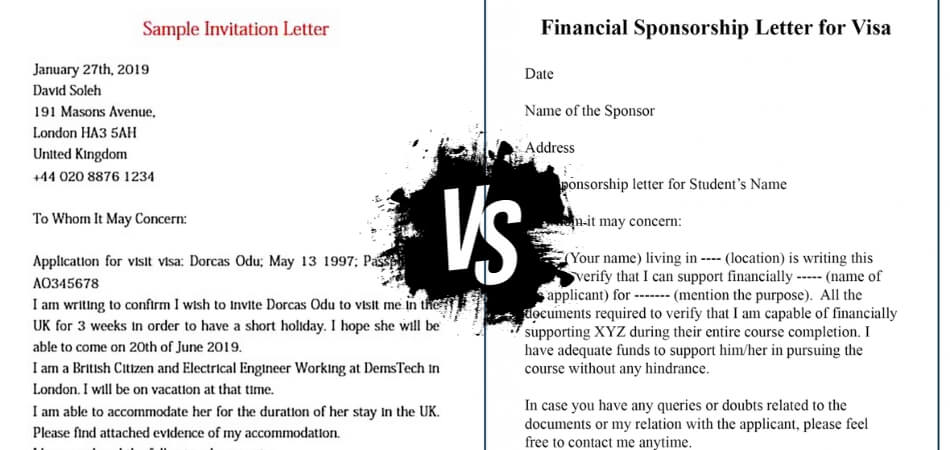When applying for a visa, familiarizing yourself with the types of supporting documents required is crucial for a successful application. There are two types of letters that are frequently requested: invitation letters and sponsorship letters. But what exactly sets them apart? What is the difference between an invitation letter and a letter of sponsorship for a visa application?
The main difference between an invitation letter and a letter of sponsorship is their purpose. An invitation letter serves as proof that the applicant has been invited by someone in the destination country, often for tourism, business, or events. In contrast, a letter of sponsorship guarantees that a sponsor will financially support the applicant during their stay, covering travel, lodging, and daily expenses.
Throughout this article, we’ll go over these documents in detail and help you pick the right one. So stay tuned.
What is the Difference Between an Invitation Letter and a Letter of Sponsorship for a Visa Application?
Visa applications can be smoother when you recognize the right documents. A letter of invitation and a letter of sponsorship are two important letters commonly required. When you know their differences, preparing the right paperwork becomes easier. Listed below are the differences between an invitation letter and a sponsorship letter:
Purpose of Each Letter
An invitation letter shows that someone in the country you want to visit has invited you. It is often used for trips like tourism, family visits, or special events. The letter proves you have a real reason to travel and that someone is expecting you. It helps visa officers trust that your visit is genuine. The letter focuses more on the relationship and the purpose.
A letter of sponsorship shows that someone will pay for your stay and expenses. This person promises to cover costs like travel, food, and a place to stay. It is important when you don’t have enough money to prove you can support yourself. The letter gives visa officers confidence that your trip will be financially covered. It focuses more on money and financial support.
Who Can Write the Letter?
Invitation letters are written by people like friends, family, or event hosts in the country you want to visit. These people share their details and explain why they want you to visit. The letter shows they welcome you and take responsibility for your visit. It must be honest and clear to avoid visa problems. The letter is usually personal and friendly.
Sponsorship letters are written by people or groups who can afford to pay for your trip. This might be a family member, employer, or organization. The sponsor needs to prove they have enough money to support you. They usually add documents like bank statements to prove this. The letter is more formal and focuses on financial support.
Required Information in the Letters
An invitation letter includes the inviter’s and visitor’s names, the visit reason, and how long you will stay. It also tells you where you will live while visiting. This information helps the visa officer understand your trip better. Clear and correct details make the letter trustworthy. It should explain the visit’s purpose simply.
A sponsorship letter says who will pay for your trip and what costs they will cover. It gives details about the sponsor’s money and their relationship to you. The letter promises full financial support during your visit. This helps visa officers feel sure you won’t have money problems. The letter must clearly state the sponsor’s commitment.
Legal Importance and Verification
Invitation letters are important, but do not promise to pay for your trip. Visa officers may still check if you have money to support yourself. The letter mainly proves your visit has a real reason and a host. Sometimes, it may need a stamp or notarization for more trust. This depends on the country’s visa rules.
Sponsorship letters have more legal value because the sponsor promises to pay your costs. The sponsor may need to give bank records or legal papers. Visa officers check these papers to stop fraud or fake letters. This letter makes your visa application stronger by showing money backup. It is very important when you cannot prove your own funds.
Impact on Visa Approval
An invitation letter helps your visa chances by showing you have a real reason to visit. It tells visa officers about your host and your visit plans. But if you don’t have proof of money, this letter might not be enough. Combining it with financial proof makes your case stronger. It is helpful, but not always enough.
A sponsorship letter improves visa approval when money is a concern. It shows officers you won’t be a financial burden during your trip. This letter is very important for longer or expensive visits. Good documents from your sponsor can make the visa process easier. It often increases the chance your visa will be accepted.
Differences in Format and Tone
The format of invitation letter usually sounds friendly and personal. They talk about your relationship with the inviter and your visit plans. The letter is simple and shows the host’s willingness to welcome you. It is easy to read and feels warm. This helps visa officers feel comfortable about your visit.
Sponsorship letters are more formal and serious. They focus on money and the sponsor’s promise to pay your expenses. The letter uses clear, official language and shows proof of money. It is often written like a business document. This makes visa officers trust the financial support.
Why Visa Officers Ask for Invitation and Sponsorship Letters?
When you apply for a visa, officers want to be sure everything is clear and true. They ask for different papers to check your plans and support during your stay. These letters help them decide if you will follow the rules and come back home. Read on to find out why these letters matter:
Proof of Visit Reason
Visa officers need to know the real reason you want to visit. An invitation letter for visa shows that someone in that country is waiting for you. This proves your visit is not random or fake. For example, if you’re attending a conference in Canada, an official letter can show the details of the event. It helps the officers trust your reason for going.
Financial Support Check
Visa officers must make sure you can pay for your stay. A sponsorship letter for a visa tells them that someone will take care of your costs. This includes things like food, travel, and where you stay. It helps officers feel that they will not face money problems. That makes your visa application stronger.
Preventing Illegal Stay
Countries want visitors to leave after their visa ends. These letters help show that you will go back home on time. If you have strong reasons to return, officers feel safer giving you a visa. An invitation or sponsorship letter shows you have a plan. That makes it easier to trust your visit.
Confirming Identity
Visa officers need to know you are who you say you are. A letter from someone in the country helps prove that. It shows you have real ties with someone there. The sponsor or host also gives their details, which helps too. This adds trust to your visa papers.
Reducing Fraud Risks
Some people try to lie or cheat during visa applications. Real letters help officers catch fake cases. If the letters are true and complete, they help show your visit is honest. It becomes easier for officers to make the right choice. That helps you and them avoid problems.
Showing Responsibility
Having these letters shows you care about the visa rules. It means you planned your trip and asked someone to support you. Officers like it when people follow the right steps. It proves you are ready to visit with care. This can help get your visa faster.
How to Request Someone to Write You an Invitation Letter?
Asking someone to write you an invitation letter might feel a little confusing at first. You may not know how to ask or what to say. But with the right approach, it can be simple and stress-free. Let’s look at how to do it the right way:
Choose the Right Person
Think about someone who truly knows you and lives in the country you want to visit. This person can be a friend, family member, or even an event organizer. Make sure they are okay with writing the letter for you. The person should also be able to give honest and clear details about your visit. Choosing the right person is the first and most important step. A strong connection makes the letter more trusted by visa officers.
Explain Why You Need It
After choosing someone, tell them why the invitation letter is needed. Let them know it’s for your visa, and it will support your application. Be honest and clear when you explain your situation. This helps them understand how important their help is. Make sure to talk in a kind and respectful way. When people know their help matters, they are more likely to say yes.
Share Visit Details
Give your host the full details about your visit. Tell them when you plan to arrive and how long you will stay. Also, let them know where you will stay and what you plan to do. This helps them write a complete and useful letter. The more details you give, the better the letter will be. It also shows that you’ve thought about your trip carefully.
Be Polite and Kind
Always use kind and simple words when you ask for help. Say please, thank you, and show that you’re truly grateful. Even if they say no, respect their choice. People are more likely to help when they feel respected and not forced. A polite request can make a big difference. Good manners always leave a good impression.
Offer Help with Letter
Not everyone knows how to write an invitation letter, so offering help is a good idea. You can give them a sample or a simple guide. Just remind them to change it to match their own words and style. This makes the task easier for them and shows you care. Helping them also shows you’re serious about your trip. It makes the process faster and smoother.
Give Enough Time
Don’t ask for the letter a day before your deadline. Try to ask at least two weeks before you need it. This gives your host time to write it without stress. It also gives you time to read it and check for any mistakes. Rushing only causes problems and pressure. Early planning shows you’re organized and respectful of their time.
Follow Up Gently
If they don’t reply in a few days, it’s okay to check back kindly. You can say something like, “Just checking in if you had time.” Don’t message too many times or sound upset. A soft reminder shows you’re serious but still polite. People often get busy, so a little follow-up helps. Always stay patient and thankful.
Best Practices for Requesting a Sponsorship Letter
Requesting a sponsorship letter can seem tricky if you’re not sure how to do it right. Knowing some helpful tips can make the process smoother and less stressful. It’s all about clear communication and showing respect. Here is how to request a sponsorship letter in the best possible manner.
Pick a Trustworthy Person
The sponsor should be someone who knows you and can help with your visa. This could be a family member, friend, or someone you trust. They must be living in the country you’re planning to visit. Make sure they are willing and able to support your trip. It’s important that the sponsor understands the responsibility.
Explain the Financial Support Clearly
When you ask, make sure to explain what kind of financial help you need. This could include travel costs, accommodation, or daily expenses. Being clear helps your sponsor understand exactly what they are agreeing to. It also prevents confusion later on. Clear communication makes things easier for everyone.
Share Your Travel Plans
Let your sponsor know your travel dates and where you’ll be staying. Sharing this information helps them write a detailed letter. It shows you have planned your trip carefully. When sponsors see you are organized, they feel more comfortable helping. Planning details are important to include.
Be Honest About Your Situation
Always tell the truth about your need for sponsorship. If you can pay for some things yourself, say so. Honesty builds trust and shows you respect your sponsor’s help. It also makes the letter more genuine and believable. People appreciate honesty in any request.
Offer to Provide Documents
Let your sponsor know you can give any papers or proof they might need. For example, you might share your flight tickets or hotel bookings. This makes it easier for them to write the letter with correct details. Offering documents shows you’re serious and prepared. It helps avoid delays later on.
Express Gratitude
Thank your sponsor not just when they agree, but also while asking. Showing appreciation makes people feel valued and respected. It encourages them to help you willingly. A little gratitude goes a long way in keeping good relationships. Always say thank you sincerely.
Keep Communication Open
After asking, keep in touch politely to see if they need more info. Answer their questions quickly and clearly. This shows you are responsible and care about the process. Being available makes the whole experience smoother for your sponsor. Good communication helps avoid misunderstandings.
When Does a Sponsor Issue a Sponsorship Letter?
Many people have difficulty determining when a sponsor should issue a sponsorship letter. There are certain moments when this letter is needed to support a visa application. It helps explain who will take care of expenses during the visit. Here are some common times when sponsors issue this letter.
Before Visa Application
Sponsors usually write the letter before you apply for a visa. This letter is part of the papers you submit to show financial support. It helps the visa officers understand that your stay will be paid for. Without this letter, your application might be incomplete. So, getting the letter early is important.
Confirmation of Financial Support
A sponsor only writes the letter once they agree to support you. They need to be sure they can handle the costs during your visit. This includes things like food, travel, and housing. Writing the letter before confirming support can cause problems later. Clear agreement is needed before the letter is issued.
When Travel Plans Are Set
It’s best if travel dates and plans are fixed before the letter is written. This way, the letter can include accurate details about your stay. It makes the letter more useful for the visa process. If the plans change after, the letter might lose some value. Having clear plans helps everyone involved.
Verification of Identity
Sponsors often write the letter after they confirm who they are sponsoring. They might check your identity or your relationship with you. This helps make the letter honest and trustworthy. Visa officers look for genuine sponsorship letters. Verifying identity helps avoid any confusion or fraud.
Upon Receipt of Supporting Documents
A sponsorship letter is usually issued when the sponsor has all the needed papers. This might include proof of income or legal status in their country. These documents support the claims made in the letter. Without them, the letter might not be accepted. Being prepared with papers is key.
If Both Parties Agree
The letter is written when both you and the sponsor agree on everything. This includes support, plans, and documents. Having clear communication makes the process smooth. Both sides feel confident about the letter. Agreement before issuing the letter is very important.
Sample of Invitation Letter and Letter of Sponsorship
When applying for a visa, you may need extra documents to support your purpose of travel. Two common ones are an invitation letter and a sponsorship letter. Below are simple examples to help you understand how each should look:
Sample of Invitation Letter
[Guest’s Name]
[Guest’s Address]
[City, Country]
Dear [Guest’s Name],
I am writing to invite you to attend my wedding ceremony on [event date] at [venue location]. It would mean a lot to have you celebrate this special occasion with us. During your stay, you’ll be staying at my home, and we’ll ensure your comfort and convenience. Looking forward to your visit and spending wonderful moments together.
Warm regards,
[Your Name]
[Address]
[City, Country]
Sample of Letter of Sponsorship
Embassy of [Country]
[Embassy Address]
[City, Country]
Dear Sir/Madam,
I, [Sponsor’s Name], confirm that I will fully support [Applicant’s Name] during their visit to [Country Name] from [arrival date] to [departure date]. I will cover all expenses, including travel, accommodation, food, and any other related costs for this trip. I have included financial documents to confirm my ability to provide this support. Thank you for considering this application.
Sincerely,
[Sponsor’s Name]
[Sponsor’s Address]
[City, Country]
[Date]
Are Invitation and Sponsorship Letters Mandatory for All Visa Types?
No, invitation and sponsorship letters are not mandatory for all visa types. Some visa types require additional documents to support the application, while others do not. Tourist, business, or student visas may request these letters, depending on the embassy’s requirements. Not every applicant must submit these letters for approval.
For instance, tourist visas often require supporting documents, such as an invitation or a visa support letter for tourists, when applying. These documents help explain the purpose of the visit and the duration of stay. If someone is covering your travel costs, a sponsorship letter can be helpful. However, embassies don’t always make it a required document.
Business and student visas may have different document needs. Some applications require detailed financial or event-related proof for approval. In these cases, a sponsorship or invitation letter can strengthen your application. Still, it’s not always a strict requirement set by embassies.
Where and How to Submit Your Invitation or Sponsorship Letter?
Submitting your invitation or sponsorship letter can be an important step in your visa application. Knowing where and how to send these letters helps avoid delays or confusion. Each embassy or consulate may have its own process. Let’s look at the common ways to submit these letters.
Visa Application Center
Most people submit their invitation or sponsorship letter at the visa application center. This is where you give all your documents in person or by mail. The staff there checks if your papers are complete before sending them to the embassy. Always ask if they need the original or a copy. This step is key to avoiding missing documents.
Embassy or Consulate
Sometimes, you might need to send the letter directly to the embassy or consulate. Some countries ask for original documents sent by mail or scanned copies emailed online. Check the specific embassy website to know their rules. Sending documents to the wrong place can cause delays. Always confirm the address and method.
Online Upload
Many embassies now use online systems for visa applications. You may be asked to upload your invitation or sponsorship letter as a digital file. Make sure the file is clear and in the correct format, like PDF or JPEG. Uploading documents this way is quick and safe. Follow the instructions carefully.
Through Your Sponsor
In some cases, the sponsor themselves can submit the letter on your behalf. This usually happens if they live in the destination country. They might send the letter to the embassy or submit it with your application. Ask if this is allowed and how to do it properly. It can save you time.
Attach with Application Form
When you fill out your visa application form, you usually attach the letter with other papers. Make sure the letter matches your application details. A letter that doesn’t fit with your form may confuse the visa officer. Always keep a copy for yourself before submitting. This keeps your records safe.
During Interview
Sometimes, you bring the letter with you to your visa interview. The officer may ask to see the letter in person. Keep it neat and easy to read. Having all your documents organized shows you are prepared. It helps create a good impression.
Frequently Asked Questions
When applying for a visa, many people feel unsure about which documents to prepare. Invitation and sponsorship letters are two that often cause confusion. These FAQs help clear up common questions and provide new details to guide you through the process.
Can I Submit Both Letters Together?
Yes, you can submit both an invitation letter and a sponsorship letter if needed. This can make your visa application stronger by showing both your travel purpose and financial support. Including both may be helpful for long trips or when the visa officer asks for extra proof. Just make sure the details in both letters match your application.
Do These Letters Need to Be Notarized?
Not all countries require these letters to be notarized, but it can help make the letter look more official. Some embassies ask for notarized letters to avoid fake or dishonest information. It’s always best to check the specific visa guidelines of the country you’re applying to. If you’re unsure, getting it notarized adds a layer of trust.
Can a Business Send an Invitation Letter?
Yes, a company or business can send you an invitation letter if your visit is for work or a business event. These letters usually mention the reason for your visit, event dates, and your role. They are more formal and help prove your business ties. Always request it on company letterhead for a professional look.
What Happens If the Sponsor Cancels Support?
If the sponsor changes their mind or cancels support, you may need to provide your own financial proof. This can affect your visa if your trip depends on their support. Always have a backup plan in case something like this happens. Inform the visa office right away if the support is withdrawn.
Can the Same Person Be a Host and Sponsor?
Yes, the same person can act as both your host and your sponsor if they are inviting and supporting you financially. In this case, they must write a letter that covers both parts clearly. This helps avoid confusion during your application. The person should also submit strong proof of income.
What if My Sponsor Is Retired?
A retired sponsor can still support you if they have enough savings or regular income, like a pension. They must show proof, such as bank statements or pension slips. Visa officers will check if they can afford your stay. Retirement doesn’t stop someone from being a valid sponsor.
How Long Should These Letters Be?
These letters do not need to be very long. A clear and direct letter of one or two pages is usually enough. The important thing is to include all the needed details like dates, names, and purpose. Long letters may confuse visa officers, so simple is best.
Can I Handwrite the Letters?
Handwritten letters are sometimes accepted, but typed letters look more formal and are easier to read. Most embassies prefer typed letters on a computer. If you must handwrite, make sure it’s very neat and clear. Avoid errors and use a pen, not a pencil.
What If My Host Lives in a Rented Home?
If your host lives in a rented place, they can still invite you. They just need to mention it in the letter and provide a copy of their rental agreement. This shows the visa officer that your stay is planned and legal. Hosts don’t have to own the home.
What Language Should the Letters Be in?
The letters should be written in the language accepted by the embassy, usually English or the country’s official language. If the letter is in another language, you may need to include a translation. Always check the embassy’s language rules before submitting. Translations should be official and clear.
Conclusion
Visa applications can feel overwhelming, but understanding which documents you need makes everything much smoother. Having the right support papers saves time, reduces stress, and increases your chances of approval.
If you’ve ever wondered what is the difference between an invitation letter and a letter of sponsorship for a visa application, remember that an invitation letter is about showing that someone in the country is inviting you for a visit. A sponsorship letter, on the other hand, shows that a person or organization will cover your expenses, making sure you won’t face money problems during your stay.
Picking the right letter for your visa type can make a real difference. Well-prepared documents show you’re serious about your travel plans and help visa officers trust your application even more!









